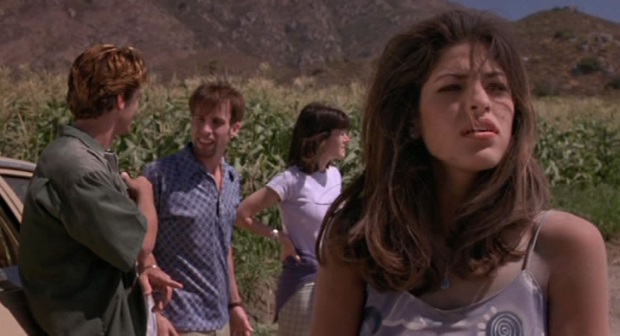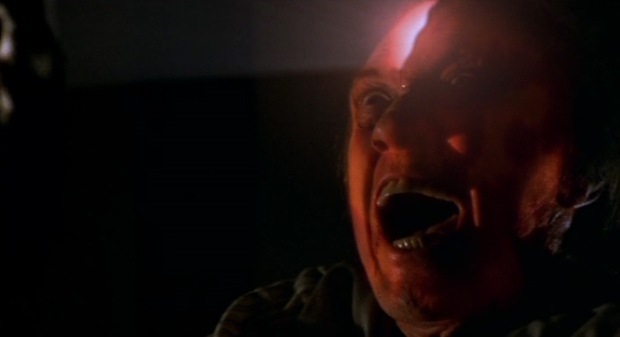Revisiting the film of Stephen King’s Children Of The Corn V: Fields Of Terror
Rebecca's back with the fifth instalment of this cereal killer saga...
The film: In the extremely punny town of Divinity Falls, Ezekiel (Adam Wylie) – who looks like Adam Driver and Barry Keoghan had a baby – encounters a burning bush in a cornfield. Instead of some holy encounter, it is, of course, our old friend He Who Walks Behind The Rows. There’s some green fire entering his chest and lo, we have our new young cult leader nightmare. Meanwhile, a group of teenagers are on a trip through the Midwest when they quite literally crash into Divinity Falls and get tangled in the latest cereal cult (geddit?). It turns out one of the teenagers is related to a cult member. So that obviously goes well.
Any pretense of connecting these films back to the original 1984 Children Of The Corn has long been dispensed now that we reach the fifth film of the franchise. Other then He Who Walks Behind The Rows and the inevitably creepy children, Fields Of Terror carves its own path through the corn. In terms of tone, it follows the more po-faced atmosphere of Children of The Corn IV: The Gathering rather than the considerably more fun Urban Harvest. And I never thought I’d find myself saying I missed Urban Harvest.

As is tradition with the Children Of The Corn sequels, there is at least one recognisable star early in their career whose appearance is a surprise. Enter Eva Mendes as Kir, our glamourous teenager soon to be seduced by our maize maniacs. Eagle-eyed Buffy The Vampire Slayer fans (both TV and film versions) will recognise Greg Vaughan from the episode Reptile Boy, in which he played a member of a frat boy cult, and Alexis Arquette who briefly appeared as a vampire DJ in the film alongside brother David. They’re all Very Earnest. Elsewhere, for much-needed gravitas, we have David Carradine, who is clearly having a blast playing creepy prophet, Luke.
Ethan Wiley’s direction is, to put it bluntly, bizarre. He seems very determined to shoot from every possible angle which leads to some vertigo-inducing shots as well as a crick in the neck. He even aims for car sickness with some of the travelling scenes. There are barely any nicely horizontally level shots and it gives the impression that every scene in the movie is taking place in a weird, constantly moving funhouse that’s not actually that fun. I guess Wiley is trying to disorientate the viewer in order to create a sense of unease, but it’s less psychological horror and more a sudden need to take Kwells.
But then, the ending happens. Have you ever wanted to see a film where David Carradine’s head splits open, something grows out of his neck, and it turns out to be a powerful flamethrower that blasts a whole through the sheriff’s head? Weirdly specific, sure, but this is the film for you. Alice Krige in Sleepwalkers murdering a cop with a corn-on-the-cob to the back is looking pretty tame now, huh? If only the rest of Fields Of Terror committed to being as gloriously unhinged as the middle of Carradine’s skull in that scene.

As I mentioned when I looked at Children Of The Corn IV: The Gathering, it’s hard to comprehend how much mileage, be it good or bad (or, let’s face it, terrible), has been mined from that one short story in Night Shift. There have been such varied tones too, from the fairly straight-faced original movie to blackly comic to unrelentingly grim. But I think where Fields Of Terror really falls down in comparison to the others is that it feels ultimately aimless. The Gathering at least had the epidemic plotline to propel itself along. Fields Of Terror tries to do something around losing your family, but it never develops into a proper theme, just an excuse for its lead actresses to do some overwrought yelling. I’m all for a good overwrought yell, but sometimes it gets too much, you know?
Scariest moment: There aren’t any particularly major scares, but for all you gore-hounds out there, the fake blood is splashed liberally throughout the film. There’s even a comedy deposit of a dismembered foot into a body bag, if you fancy a quick giggle of the black humour kind.
Musicality: In a way that feels counterproductive to a horror score, Paul Rabjohns’ music isn’t all that memorable. Bring back the choral nightmare of the earlier films please.
A King thing: I’m not sure there’s that much of King in here anymore beyond the typical small-town American horror. I wonder if he’s baffled about how many films have emerged from that one short story.
Join me next time, Constant Reader, for a lesson with an Apt Pupil.